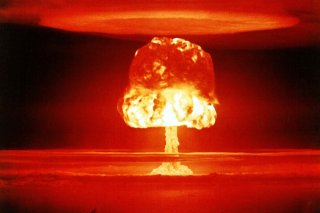Shock and Awe: Meet the Most Powerful Nuclear Weapon Ever Tested
A story told in megatons.
Key Point: We will most likely never see anything this big again, and for good reason.
“Fear is the oldest weapon in history. Throughout the life of mankind, it has been the resort of those who could not hope to prevail by reason and persuasion. It will be repelled today, as it has been repelled in the past — not only the steadfastness of free men but by the power of the arms which men will use to defend their freedom.”
So was the statement issued by the White House on October 31st, 1961, after the Soviet Union tested a nuclear bomb unlike any that had ever been tested before.
Going Nuclear
Tsar Bomba was the Soviet Union’s largest nuclear test — and the largest nuclear explosion ever created by man.
A specially modified Tupolev Tu-95 bomber, a turboprop first flown in 1952, and still in use with the Russian Federation today, was chosen to carry the bomb. Outwardly at least it was somewhat similar to the nuclear bombs dropped on Hiroshima and Nagasaki during the Second World War. But it was bigger. Weighing nearly 27 tons, it was truly a monster bomb.
The Tu-95 was accompanied by a smaller, jet-engine Tupolev Tu-16. The Tu-16 was to film and photograph the explosion from the air, and take air samples, as the crews rushed to safety. Both airframes were painted a reflective white, in the hope that the flash from the explosion could be at least somewhat reflected, hopefully, to protect the aircrews.
The leviathan bomb was equipped with a giant parachute that would hopefully unfurl upon release, slowing the descent of the bomb and giving the crews the opportunity to punch the throttle and beat a hasty retreat. If all went according to plan, the bomb would detonate in the air, above ground.
Not that it mattered much anyway. Soviet engineer’s calculations indicated the explosion would be so large, they deemed the two plane’s chance of survival at around 50-50.
The Age of Man
A cameraman who observed the explosion from the air said the following:
“The clouds beneath the aircraft and in the distance were lit up by the powerful flash. The sea of light spread under the hatch and even clouds began to glow and became transparent. At that moment, our aircraft emerged from between two cloud layers and down below in the gap a huge bright orange ball was emerging. The ball was powerful and arrogant like Jupiter. Slowly and silently it crept upwards.... Having broken through the thick layer of clouds it kept growing. It seemed to suck the whole earth into it. The spectacle was fantastic, unreal, supernatural.”
But escape they did. Flying at maximum speed, both planes protective white paint burned off. The shock wave caught up with the Tu-95 that released the bomb, causing the bomber to lose nearly 3,500 feet of altitude. Luckily, the crew was able to regain control and land safely.
700 kilometers a way, a shockwave could be observed. House windows 900 kilometers away were broken. Radio signals were totally interrupted for nearly and hour. The iconic nuclear mushroom cloud could rose to 210,000 feet and could be seen for hundreds of miles in every direction.
Soviet engineers had assumed that the fireball would touch the ground and scorch a huge crater. So great was the shockwave from the blast, it ricocheted off the ground and pushed the fireball upward, preventing it from even touching the ground.
Real Estate Limitations
As a weapon, the Tsar Bomba was never practical. The cities of Chicago, New York, or Washington D.C. were too far to practically carry in a bomber from Russia to the United States. Mounting it on an intercontinental ballistic missile was also out of the question, due to the enormously heavy payload size.
Still, the Tsar Bomba achieved what it was designed for: to shock and to awe both the United States and NATO allies. We will most likely never see anything that big again, and for good reason.
Caleb Larson is a Defense Writer with The National Interest. He holds a Master of Public Policy and covers US and Russian security, European defense issues, and German politics and culture. This article first appeared earlier this year and is reprinted due to reader interest.
Image: Flickr

